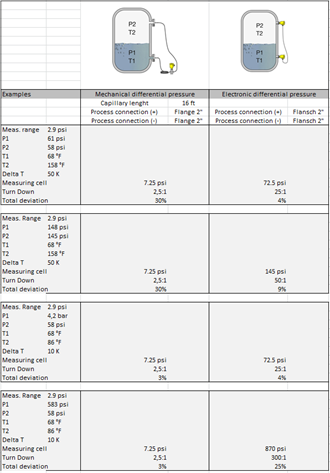Calculation of the total deviation
Ftotal = Fperf + Fstab
The basic accuracy Fperf is made up of the thermal change of the zero signal and output range FT as well as the measuring deviation FKl:
Fperf = √((FT)2 + (FKl)2)
Initially, this only applies to the digital signal output via HART, Profibus PA or Foundation Fieldbus. For a 4 … 20 mA output, there is also the thermal change of the current output Fa:
Fperf = √(( FT)2 + (FKl)2 + (Fa)2)
For a better overview the formula terms are listed as follows:
Ftotal: total deviation
Fperf: basic accuracy
Fstab: long-term drift
FT: thermal change of zero signal and output range (temperature error)
FKl: measuring deviation
Fa: thermal change of the current output
Calculation example
Comparison of the mechanical (left) and the electronic differential pressure measurement (right) for selected measuring constellations.
Based on a level measurement example in a pressurised vessel, the differences between the mechanical and the electronic differential pressure measurement are shown in simplified terms. The calculation is based upon the previously mentioned German Pressure Standard DIN 16086.
The table shows that the electronic differential pressure measurement delivers a higher measuring accuracy especially at great temperature differences. This applies even with a high turn down. But it also shows that turn down and measuring accuracy in the mechanical differential pressure measurement are independent of the pressure constellation – at least at low temperature differences.


